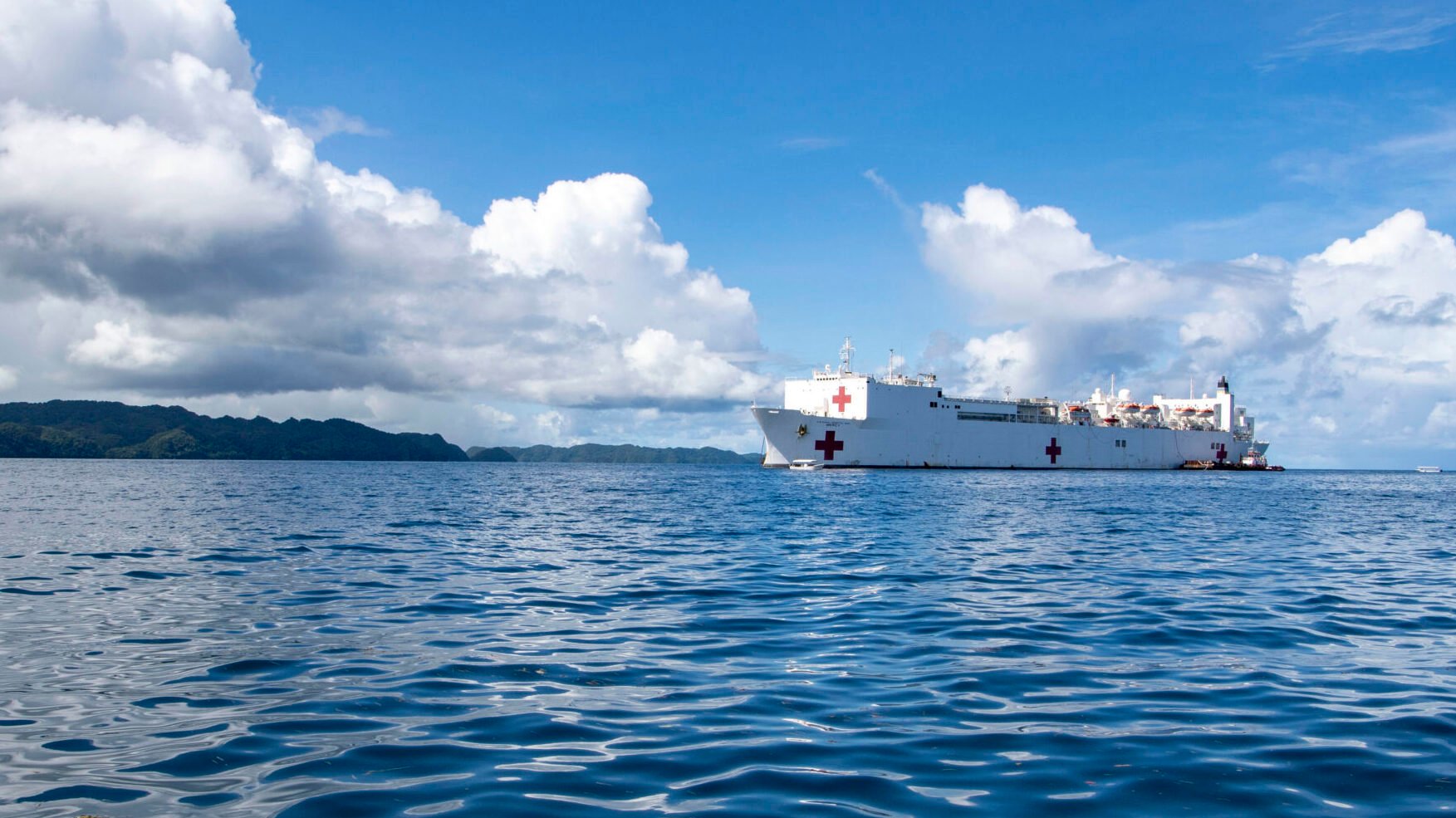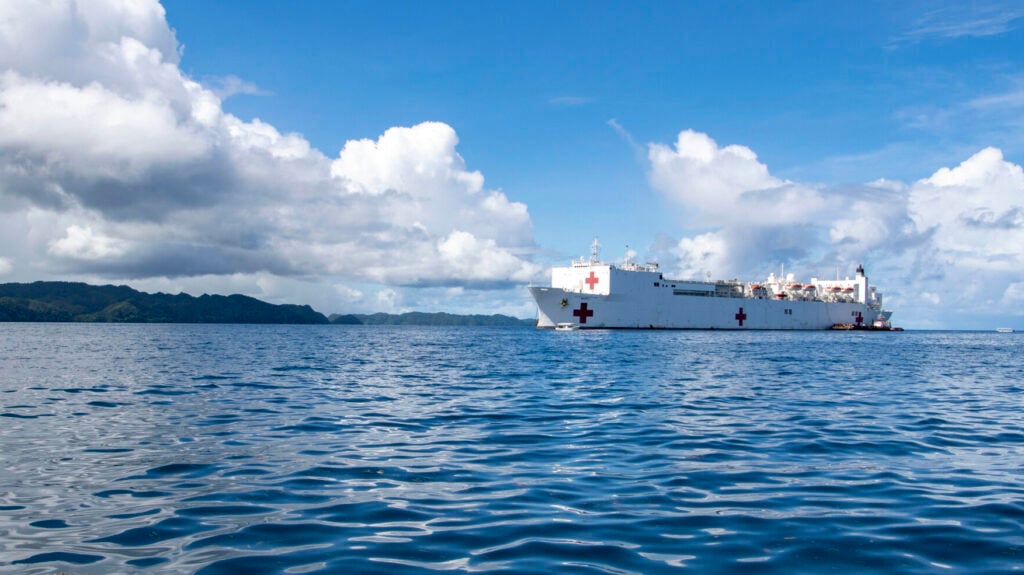
The hospital ship Mercy (T-AH 19) sits at anchor upon its arrival off the coast of Koror, Palau during Pacific Partnership 2022. (U.S. Navy photo by Mass Communication Specialist 2nd Class Brandie Nuzzi)
WASHINGTON — Two US senators have called on the White House to send one of the Navy’s hospital ships to the Middle East in response to the humanitarian crisis in Gaza, but experts told Breaking Defense there are numerous challenges that would make doing so a logistical nightmare — even before considering the politics of the operation.
The call to action came from Sens. Jack Reed, D-R.I., and Angus King, I-Maine, who last week sent a letter to the White House arguing that the US should deploy either the ships Mercy (T-AH-19) or Comfort (T-AH-20) as well as work with the “Israeli and Egyptian governments to establish maritime logistics routes and ensure civilian access to aid.” The letter was published prior to the administration announcing, and US Central Command executing, an operation to airdrop supplies over the weekend.
The hospital ships have garnered the US Navy positive attention globally due to their easily recognizable white hulls and red crosses, combined with their deployments to aid foreign countries in the aftermath of natural disasters. The Mercy and Comfort have 1,000 patient beds each, medical personnel vetted by the Pentagon and facilities stocked with supplies and power generation independent from infrastructure ashore.
RELATED: With new $867M contract, Austal begins work on replacements for Navy’s storied hospital ships
The senators briefly acknowledge “the risks” the operation would face but argue the “military has the expertise in managing risk” and could cease operations if conditions become intolerable. But experts told Breaking Defense the challenges of doing what Reed and King suggest — deploying an American hospital ship to a combat zone under threat from terrorist organizations — will start well before either ship gets anywhere near Gaza.
From Staffing To Weeks At Sea
Brent Sadler, a fellow at the Heritage Foundation, said just staffing a hospital ship with its full complement of crew will take time — a luxury that civilians in Gaza lack. Unlike warships that have sailors assigned and ready to deploy on short notice, hospital ships are kept in “reduced operating status” (ROS) between deployments.
ROS means just a small crew of mariners monitor and maintain the ships on a day-to-day basis. The hundreds of doctors, nurses and medical staff needed to treat patients must be brought in from non-governmental organizations, the military’s reserves or active-duty personnel who would ultimately be pulled away from other facilities where they are needed.
And even once the crew is staffed, there is also the time it would take for the ship to reach the Middle East. Sadler recalled when a typhoon hit the Philippines in 2013 and members of Congress urged the Navy to deploy Mercy or Comfort.
“The problem [was] the hospital ship was in San Diego, and it was just getting people on board. … The hospital ship is going to take a month to get across the Pacific. It’s going to take two more weeks before it’s got the crew in place,” he said. The Navy will “get the hospital ship [on site] when [they] can, but that’s in six weeks, and we’re in the midst of that disaster response right now.”
He noted the one scenario in which the prep time could be cut short is if either ship were already deployed and diverted, but that is not the case today. A Navy spokeswoman confirmed to Breaking Defense on Tuesday that both Mercy and Comfort, which are homeported on opposite coasts of the United States, remain in port. She deferred questions about the senators’ letter to the White House where a spokesperson for the National Security Council did not respond to a request for comment by press time.
The Diplomatic Tangle
If the US did deploy a hospital ship to Gaza, it would not be the first. At least two countries, France and Indonesia, have reportedly deployed their respective vessels to Egyptian ports and are working with that country to provide aid, a fact noted by the senators in their letter.
But the comparison may not be hospital ships to hospital ships. Mercy and Comfort are exponentially larger than either the French or Indonesian vessels. American hospital ships at full capacity have enough staff and space to care for up to 1,000 patients. Media reports indicate the French ship is suited for just a few dozen patients. Meanwhile, the Indonesian government in January said its ship was only tasked to deliver supplies, rather than act as a floating hospital.
The difference in ship size matters for operations planners inside the Pentagon: The much larger American hospital ships usually stay far away from foreign coastlines or ports when deployed to avoid accidental grounding. Patients are either ferried by smaller vessels or helicopter, which raises numerous security questions for a deployment to Gaza, said Jonathan Lord, a fellow at the Center for New American Security.
One option is to coordinate with Egypt to evacuate people across the border, vet them for admission to the hospital and arrange their transportation from shore to ship, but Lord warned that is not a small ask diplomatically.
The Egyptians “are incredibly rigorous and there is indeed a tremendous amount of control that the Egyptian government has put on their side of the Rafah Crossing,” said Lord, who has worked with various governments across the Middle East as both a staffer in Congress and a Pentagon policy analyst. The Rafah Crossing is the primary land route between Egypt and Gaza.
An alternative would be to put American personnel on the ground in Gaza, but that “would require real coordination with all the actors, including the Israelis, is considerably higher risk, and makes the act of airdropping foodstuffs seem small in terms of military activity,” said Lord, who added it’s likely a non-starter.
A third possibility would be for the American hospital ship to go to an Israeli port, likely yet another non-starter, Lord said, given the political and diplomatic tensions between President Joe Biden and Israeli Prime Minister Benjamin Netanyahu.
Indeed, any of these scenarios in which Mercy or Comfort are deployed to the Middle East would require a tremendous amount of political will on the White House’s part, and it is not clear what position the Israelis would take on it.
The Danger Of Close-In Assistance
Perhaps most concerning from the Pentagon’s perspective is the question of protecting the ship itself. The gleaming white hulls and large red crosses are not merely symbolic. They distinguish Comfort and Mercy from a warship, deterring a professional military from striking it due to the clear prohibitions in the Geneva Conventions against attacking hospitals. But the Houthis, Hamas, Hezbollah and other US adversaries involved in the conflict in Gaza are not professional militaries.
“That’s part of the security associated with the employment” of a hospital ship, said Mark Montgomery, a retired rear admiral and fellow at the Foundation for Defense of Democracies. “It could be a terrorist sneaks in as a wounded person. It could be … missiles fired out towards the [ship] if it’s too close to shore.”
Montgomery said the US could defend the ship by placing destroyers near it, but added it’s not the “optimal look” for a vessel meant to be rendering aid to civilians to be surrounded by warships.
The notion of sending a hospital ship to Gaza does have at least one high-profile proponent who is intimately familiar with the US Navy: Retired Adm. James Stavridis. Writing in Bloomberg, the admiral in November said the US should do precisely what the senators are suggesting now. He acknowledged many of the same risks experts raised with Breaking Defense but ultimately argued the White House should proceed regardless. A spokesperson for Stavridis declined a request for an interview.
All of the analysts interviewed by Breaking Defense expressed skepticism about whether sending a hospital ship to Gaza is the correct move for the US, strategically or politically. But Montgomery, who said the ship’s presence in the region would send a strong message of support to innocent civilians in the region who have been injured, argued the operation is plausible.
“It’s tough to execute it. It’s tough to deploy it and it’s tough to utilize it,” he said. It’s “not impossible, and there’s certainly some redeeming features to the signal it would show, but, these are tough challenges.”


